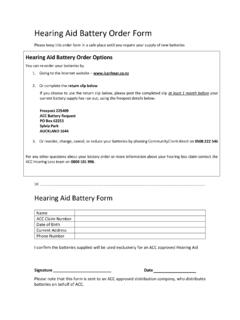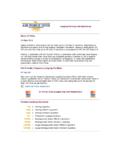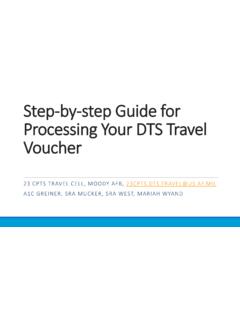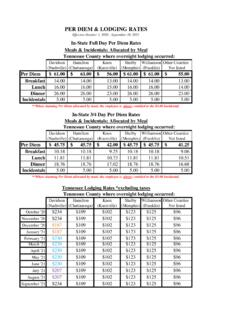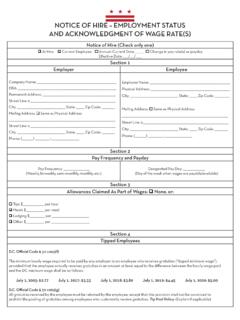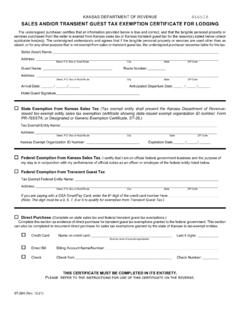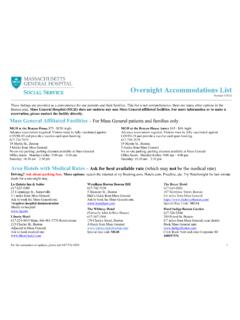Transcription of Treatment Injury - ACC
1 Treatment Injury Claim Lodgement Guide ContentsIntroduction 3 Should I lodge a Treatment Injury Claim with the patient s consent? 5 Criteria and examples 6 Clinical information needed for a claim 8 Treatment Injury Claim timeframes 9 Best practice in lodging Treatment Injury Claims 10 Establishing whether a client has cover 11 Where do I go for more information? 11 Appendix 1: Definitions 12 Appendix 2: Underpinning legislation 142 What is the purpose of this guide?This guide is to help District Health Boards (DHBs) and Registered Health Professionals (RHPs) advise patients on whether to lodge a Treatment Injury average, a third of Treatment Injury Claims are declined each year. Giving DHBs and Registered Health Professionals clearer guidance on when to lodge a Treatment Injury Claim will lead to: more appropriate claim lodgement, leading to greater confidence that a claim will be accepted improved patient experience as expectations are managed more effectively more time and resources within DHBs that can be focused on patient care and successful is a Treatment Injury Claim?
2 It is a claim to ACC to cover an Injury caused to a patient by Treatment from a Registered Health Professional. The claim must be lodged with the consent of the an Injury is covered, ACC may pay or contribute to the cost of Treatment , rehabilitation and are three core requirements which need to be met in order for a claim to be accepted. These are explained in more detail later in this guidance: an Injury has occurred that has resulted in physical harm or damage to the patient the Injury has been caused by Treatment the Injury is not a necessary part or an ordinary consequence of Treatment , having regard to the clinical knowledge at the time of Treatment , and the underlying health condition of the Treatment Injury Claims are considered by ACC on the basis of the specific circumstances of each patient. Differences in the underlying health conditions or the context of Treatment can mean that a claim that is accepted for one patient may not be accepted for another is this guide for?
3 This guide is for those involved in the process of lodging a Treatment Injury Claim, and is tailored for health professionals who are eligible to lodge claims and those submitting the claims on behalf of the guide refers to DHBs, if relevant this should also be taken to include private surgical hospitals and other health care should I use this guide?This guide should be used as a reference, to inform the decisions you need to make to lodge a Treatment Injury Claim appropriately. Use this guide to: identify what you need to discuss with your patient before lodging a claim, including making sure they have given their consent help you decide whether to lodge a Treatment Injury Claim confirm the key information you need to send to ACC to help a timely guide can be used to inform DHB policy on Treatment Injury Claims, and is intended to supplement other DHB policies, such as informed consent and open disclosure the Guide4 Has an event* happened?
4 Define the Injury in terms of body site, body side and nature of the tissue damageCheck the section of this guide on when a claim is unlikely to be accepted. If unsure discuss with your ACC liaisonFollow open disclosure policy and confirm patient s consentPass claim to ACC liaison team. Be prepared to write a report to assist with the liaison team lodging the claimYESYESYESYESAre you able to explain how the Treatment has probably caused the Injury ? Treatment Injury Claim likely to be unsuccessfulnoHas Treatment been provided by a Registered Health Professional? Treatment Injury Claim likely to be unsuccessful, but consider if the Injury is a Personal Injury Caused By Accident (PICBA)noDid the Treatment result in physical harm or damage? Treatment Injury Claim likely to be unsuccessfulno* An event can include when Treatment has not been provided by mistake, or has been given unreasonably sections on criteria and definitions for more detailShould I lodge a Treatment Injury Claim with the patient s consent?
5 55 What is a personal Injury ?A personal Injury is a physical Injury where bodily damage has been suffered. For example, an Injury such as a fracture may be accompanied by the symptoms of pain or aching. However, lodging a claim based solely on symptoms (such as pain or aching) without an identifiable physical Injury will not be is Treatment ? Treatment has a very broad definition, though it must have been administered by, or at the direction of, a Registered Health Professional in respect of their includes diagnosis, a decision on the Treatment to be provided or not provided, a failure to provide Treatment at all or in a timely manner, obtaining or failing to obtain consent, and failure of equipment. The full definition is set out in Section 33 of the AC Act 2001. What counts as causation ?To be covered, the personal Injury must be caused by Treatment . You will need to provide an explanation as to how the Injury was caused by the Treatment . Causation is considered on the balance of probability, not possibility.
6 Circumstances of the treatmentThe circumstances of the Treatment should be taken into account when deciding whether to lodge a Treatment Injury Claim. This includes the: underlying health condition of the patient at the time of Treatment , and clinical knowledge at the time of underlying health condition of a patient may make an Injury that is caused by Treatment ordinary , where in a different patient it would not be. For example, a patient with widespread atherosclerosis and diabetes suffers a wound infection after having a small skin lesion removed from their toe, which may be considered as ordinary . Given the underlying diseases, an infection may be an ordinary outcome even with careful surgery. ACC cover under a Treatment Injury Claim would be is eligible for ACC support through a Treatment Injury Claim?ACC support is available to all New Zealand residents and temporary visitors to New Zealand, who received Treatment in New Zealanders who are ordinarily resident may also be covered if they are injured overseas.
7 There are specific rules around the circumstances in which a resident would be covered if injured overseas. If you have a patient in this situation, contact your ACC Liaison in your DHB to Asked Questions66 When is a claim unlikely to be accepted?There are circumstances in which an Injury resulting from Treatment may not be covered by ACC. If the claim does not meet the legislative criteria, it will be declined. Some examples are described Appendix 1 for definitions of key terminology, and Appendix 2 for the underpinning is insufficient evidence of a physical injuryLack of evidence of a physical Injury caused by Treatment is the most common reason for a claim to be declined, accounting for almost two thirds of declined claims. For example, a claim may be lodged for a patient who is experiencing dizziness but has no sign of physical damage after receiving medication prescribed for a different patient. In this case, there is no physical Injury and so a claim would be unlikely to be Injury is a necessary part of the treatmentFor example, a patient has surgery to remove a tumour.
8 During the operation, the surgeon has to cut a nerve in order to access the tumour. The patient subsequently loses movement of some muscles and experiences numbness. Cutting the nerve was a necessary part of the Treatment and so a Treatment Injury Claim would be unlikely to be accepted. The Injury is an ordinary consequence of the treatmentFor example, two men of similar age are admitted to hospital for emergency surgery. Both patients need a midline incision, one for appendicitis and the other for a ruptured aneurysm of the abdominal aortic artery. Both patients heal well without infection in the wound, but both develop a hernia at the site of the patient with appendicitis has never smoked and has no previous medical problems. His claim for incisional hernia is likely to be patient with the ruptured aneurysm of the abdominal aortic artery, is a smoker with long standing high blood pressure, so the incisional hernia is likely to be considered an ordinary consequence and a Treatment Injury Claim would be unlikely to be patient has withheld consent for the treatmentFor example, a patient declines to complete a course of medication and their condition gets worse as a result.
9 A Treatment Injury Claim would be unlikely to be Injury has been caused solely by resource allocation decisionsFor example, a patient is on a prioritised waiting list for a hip replacement and their hip arthritis gets worse while they are waiting for surgery. The patient s GP has updated the DHB on the patient s deteriorating symptoms and the patient is reprioritised to bring forward the surgery. A Treatment Injury Claim would be unlikely to be accepted in this desired results of the Treatment have not been achievedFor example, a Treatment Injury Claim for a patient who has had cosmetic surgery and is not satisfied with the results would be unlikely to be accepted. A Treatment Injury Claim for pregnancy after a properly inserted Intrauterine Contraceptive Device (IUCD) also would be unlikely to be accepted. 77 What clinical information is needed?Where available and relevant you should gather: Case notes from the Registered Health Professional who undertook the Treatment .
10 Treatment Injury Claims can only be made where the Treatment was provided by, or at the direction of a Registered Health Professional. The following documents (where they apply): laboratory reports referral letter x-ray reports MRI reports operative notes consent forms discharge summaries. A Clinical Incident Review, if completed for the Injury and event A letter explaining the reason for the claim, or a report about the Treatment event, especially if the situation is particularly information is needed to show that the Injury happened, and that it was caused by the Treatment . It is important to be able to explain and show how the Treatment caused the Injury . If the Treatment that caused the Injury was not given in your DHB, provide what you can in discussion with your aims to make decisions on claims as quickly as possible. You should send in clinical information to support the claim as soon as it is available, so that ACC can start to investigate the particularly complex claims, ACC may seek expert clinical information needed for a claim8 Treatment Injury Claim timeframesHow long will it take to get a decision from ACC?


